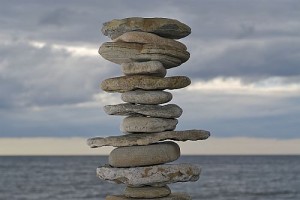
I saw this article in the NY Times yesterday on balance training for the elderly. I braced myself for the fallout.
As per usual when these sorts of articles come out, clients phone in wanting to know the skinny on the issues. One of my long standing senior clients (of almost 10 years), Phyllis, called me and ever so politely asked if we could incorporate the balance training she read about in the article into her routine. (She's such a sweetheart!)
I thought - "Oy vey. How do I say this to her?"
I explained that for one, there really is no such thing as "a balance" when it comes to the human body. (I'm not talking chakras or spirituality here). Unless you have an inner ear, visual or other equilibrioception problem, the main cause of loss of balance, such as falling when a bike messenger whizzes by or when stepping off a high step, is muscular weakness.
According to Dr. Richard Schmidt, author of the book Motor Control and Learning (my additions are in parens):
A common misconception is that fundamental abilities (running, gymnastics, etc.) can be trained through various drills or other activities. The thinking is that, with some stronger ability, the athlete will see gains in performance for tasks with this underlying ability.
For example, athletes are often given various "quickening" exercises, with the hope that these exercises would train some fundamental ability to be quick, allowing quicker response in their particular sports.
Coaches (as well as physical therapists) often use various balancing drills to increase general balancing ability, eye movement exercises to improve vision, and many others. Such attempts to train fundamental abilities may sound fine, but usually they simply do not work. Time, and often money, would be better spent practicing the eventual goal skills. (Meaning, if you want to get better at running the bases in baseball for example, run the actual bases. Don't run around traffic cones, over care tires, ropes or anything else.)
There are two correct ways to think of these principles. First, there is no general ability to be quick, to balance, or to use vision. Rather, quickness, balance, and vision are each based on many diverse abilities, so there is no single quickness or balance ability, for example, that can be trained.
Second, even if there were such general abilities, these are, by definition, genetic and not subject to modification through practice. Therefore, attempts to modify an ability with a nonspecific drill are ineffective. A learner may acquire additional skill at the drill which is, after all, a skill itself, but this learning does not transfer to the main skill of interest.
The bottom line here is, though the trainer in the picture is clearly well meaning, he is making that woman sit on that ball with one leg out for nothing. He is not improving her balance - save for the balance required to sit on a ball with one leg out. What these balancing tasks can do for people is make them a smidge stronger but in a very inefficient and unproductive manner. This is the real reason why some people improve their balance from doing these tasks. Sadly, many people are very, very weak especially the elderly. This country would save millions perhaps billions of dollars if we'd strength train our seniors. I have seen what I think are real life miracles in my gym over the years in many older folks. It is most rewarding to experience.
In the time spent doing balance training, the same time would be better spent doing a full body strength training workout (with weights, machines, etc.) to improve and increase a person's lean mass.
So yes, all those BAPS boards, wobbly boards, Bosu discs and other balance training devices you hear abour or have seen (or perhaps used!) are just glorified Romper Room toys. Use them for fun if you like, but don't think they are doing anything for your "balance."











